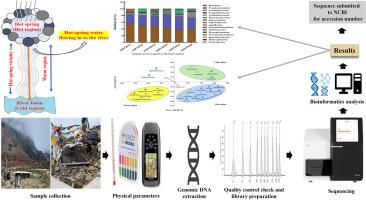地热梯度上的细菌多样性:锡金高海拔喜马拉雅温泉栖息地的启示
IF 5.8
Q1 MICROBIOLOGY
引用次数: 0
摘要
地热栖息地为研究微生物对不同温度条件的适应性提供了一个独特的机会。在这种环境中,不同的温度梯度促进了微生物群落的多样性,每个群落都适应其最佳生态位。然而,这些梯度高海拔温泉中细菌种群的复杂动态在很大程度上仍未得到探索。我们假设,温度是微生物多样性的主要驱动因素,而细菌的丰富程度在中间温度达到顶峰。为了研究这一点,我们使用 16S rRNA 扩增子测序分析了三个温度区域的细菌多样性:56-65 ℃ 的高温区(温泉)、35-37 ℃ 的温暖区(温泉水流向河流的路径)和 4-7 ℃ 的低温区(河流流域)。研究结果表明,芽孢杆菌科(Bacillota)的数量最多(45.51 %),其次是假单胞菌科(Pseudomonadota)(32.81 %)和放线菌科(Actinomycetota)(7.2 %)。芽孢杆菌和绿僵菌在炎热和温暖地区生长旺盛,而假单胞菌在凉爽地区生长旺盛。核心微生物组分析表明,温暖地区的物种丰富度最高,而寒冷和炎热地区的物种丰富度均有所下降。有趣的是,葡萄球菌出现了异常,在池塘用于沐浴和娱乐的情况下,葡萄球菌的数量更多。相比之下,梭状芽孢杆菌主要出现在寒冷地区,这可能是由于其在土壤中的生存能力以及作为孢子形成菌保持休眠的能力。温暖地区的细菌多样性最高,而寒冷和炎热地区的丰富度都有所下降。这凸显了微生物群落的温度依赖性,在适度的热量条件下具有最佳的多样性。这项研究为了解高海拔地热系统中的微生物动态提供了新的视角。本文章由计算机程序翻译,如有差异,请以英文原文为准。

Bacterial diversity along the geothermal gradients: insights from the high-altitude Himalayan hot spring habitats of Sikkim
Geothermal habitats present a unique opportunity to study microbial adaptation to varying temperature conditions. In such environments, distinct temperature gradients foster diverse microbial communities, each adapted to its optimal niche. However, the complex dynamics of bacterial populations in across these gradients high-altitude hot springs remain largely unexplored. We hypothesize that temperature is a primary driver of microbial diversity, and bacterial richness peaks at intermediate temperatures. To investigate this, we analysed bacterial diversity using 16S rRNA amplicon sequencing across three temperature regions: hot region of 56–65 °C (hot spring), warm region of 35–37 °C (path carrying hot spring water to the river), and cold region of 4–7 °C (river basin). Our findings showed that Bacillota was the most abundant phylum (45.51 %), followed by Pseudomonadota (32.81 %) and Actinomycetota (7.2 %). Bacillota and Chloroflexota flourished in the hot and warm regions, while Pseudomonadota thrived in cooler areas. Core microbiome analysis indicated that species richness was highest in the warm region, declining in both cold and hot regions. Interestingly, an anomaly was observed with Staphylococcus, which was more abundant in cases where ponds were used for bathing and recreation. In contrast, Clostridium was mostly found in cold regions, likely due to its viability in soil and ability to remain dormant as a spore-forming bacterium. The warm region showed the highest bacterial diversity, while richness decreased in both cold and hot regions. This highlights the temperature-dependent nature of microbial communities, with optimal diversity in moderate thermal conditions. The study offers new insights into microbial dynamics in high-altitude geothermal systems.
求助全文
通过发布文献求助,成功后即可免费获取论文全文。
去求助
来源期刊

Current Research in Microbial Sciences
Immunology and Microbiology-Immunology and Microbiology (miscellaneous)
CiteScore
7.90
自引率
0.00%
发文量
81
审稿时长
66 days
 求助内容:
求助内容: 应助结果提醒方式:
应助结果提醒方式:


